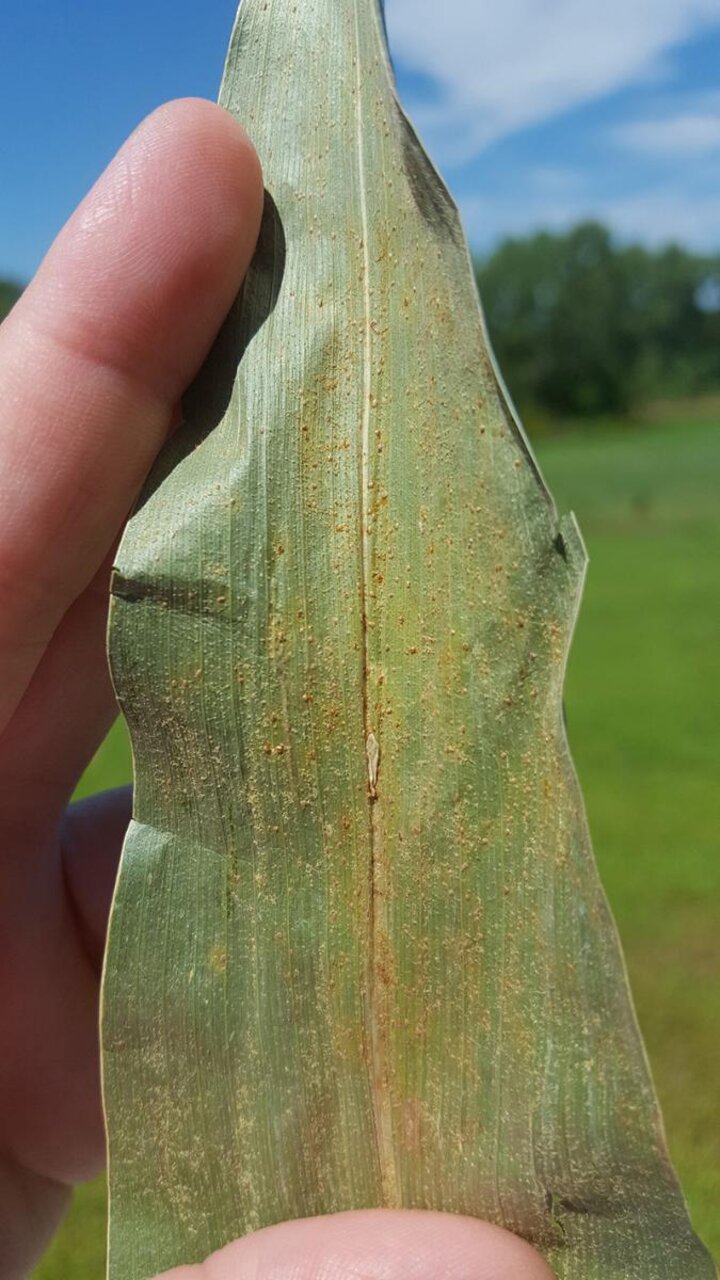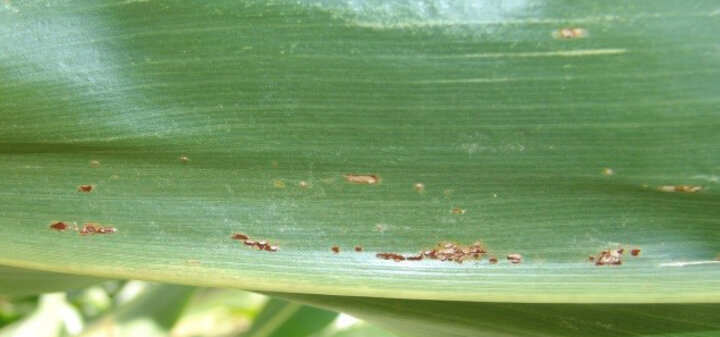Southern Rust
Southern rust (Figure 1) has been confirmed in samples from 10 Nebraska counties — Adams, Butler, Clay, Fillmore, Lancaster, Nuckolls, Pierce, Polk, Thayer, and Valley. All were from fields with a low incidence of disease at the time. Southern rust is likely more widespread than just these counties. Scouting is recommended to determine its distribution in your fields and area.
Warm temperatures and high humidity will promote development and spread of disease. Rust diseases produce large amounts of spores that can be easily moved by wind for long distances. The fungus can quickly cause disease during favorable conditions because most commercial dent corn hybrids have little resistance to the disease.
Having a history of southern rust in corn does not have any impact on disease development now, because this pathogen does NOT overwinter in infected residue. The spores must be carried into the area by winds from diseased areas. Southern rust has been confirmed across much of Kansas and other states to our South. If the disease continues to spread and worsen in Nebraska, those fields planted later are at highest risk for disease and potentially severe yield impacts because of how early the disease is developing. However, it is important to remember that it can take anywhere from a few days to several weeks for widespread and severe southern rust to develop if it is going to do so. For that reason, we recommend scouting fields, especially those at higher risk, such as later planted fields that are earlier in their maturity and have the greatest potential for yield loss.
Many people have noted the lack of activity on the southern corn rust monitoring website (ipmPIPE) that historically was used to track observations of southern rust across the country. Federal funding for this website and its affiliated southern rust monitoring projects was eliminated and activity there by state pathologists has greatly declined during the last two years. The Nebraska section is being maintained; however, information for some states may not be current. Access reports from local university plant pathologists, diagnostic laboratories, and county Extension offices for the most recent information regarding southern rust distribution.

The characteristics used for differentiating common rust and southern rust are described and illustrated in the NebGuide, Rust Diseases of Corn in Nebraska. The simplest and most reliable way to differentiate the diseases without a microscope is to examine both leaf surfaces for spore production. Southern rust spore production is usually limited to the upper leaf surface and tends to be tan to orange. The most reliable method for identifying corn rust diseases is based on examination of microscopic spore characteristics. This can be done for samples submitted to the UNL Plant & Pest Diagnostic Clinic.
Gray Leaf Spot
Gray leaf spot fungal disease has begun to develop in some areas of the state during recent days. Look for gray to tan rectangular lesions that develop on lower leaves first. Gray leaf spot lesions don’t cross leaf veins, giving them smooth linear margins. If favorable conditions continue, lesions will grow larger, taking up more leaf area, and develop higher on the plant with greater potential for yield impact above the ear leaf.
Common Rust
Common rust has been developing across Nebraska for several weeks (Figure 2). Common rust spores are usually brick-red to brown in color, however, the color difference is not a reliable method for identification when both are not available for comparison and because the spore type can change and turns black later in the season for both diseases. Common rust spores can be produced abundantly on both the upper and lower leaf surfaces. Common rust is usually not a substantial threat to plant health and corn yield, as many contemporary hybrids already have some resistance that slows spread of the disease.

Fungicides
Timely fungicide applications can be very effective at controlling rust and other fungal diseases in corn. It is important to remember that making applications too early might mean that the protection they provide may be worn off before substantial southern rust or gray leaf spot develops, leaving plants vulnerable to disease spread. Systemic fungicides can provide protection from disease spread for about 21 days, so application timing is important to make the best use of the protective and curative characteristics of the products. Applications made several weeks ago likely no longer provide protection from fungal foliar diseases. Pay close attention to the label restrictions on the most recent version of the product’s label as changes have been made for pre-harvest intervals and other use parameters.
A list of foliar fungicides labeled for use on corn in Nebraska and their characteristics are summarized in the 2015 Guide for Weed Management with Insecticides and Fungicides. Results from foliar fungicide trials conducted in Nebraska corn are available in CropWatch. These results were gathered from trials with natural infestations of gray leaf spot and sometimes mild southern rust.
Physoderma Brown Spot
Another disease that has begun to develop in Nebraska corn fields is Physoderma brown spot. This disease is normally not a concern, except in rare cases, such as on susceptible hybrids exposed to wet conditions. However, the yellow lesions on the leaf blade may be misleading for some people who mistakenly call it southern rust.
The pathogen causing Physoderma brown spot requires standing water on plant parts. Lesions can develop in a banding pattern across the leaves after they emerge through the plant’s whorl during alternating wet/dry periods. The pattern can appear across whole leaves or all the leaves of a plant. Lesions may develop in both the midrib and on the leaf blade with very different appearances (Figure 3). On the leaf blade, the small yellow/brown lesions may be alarming and appear similar to southern rust pustules, but lack the colored spores on the surface that can be wiped away. Lesions that develop in the midrib are often larger than those on the leaf blade and are usually black. The pathogen overwinters in infected corn residue from previous seasons. Management of Physoderma brown spot is rarely necessary.

